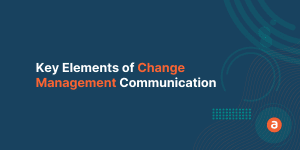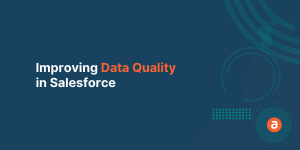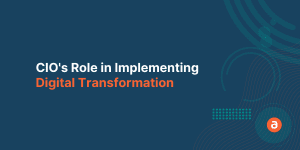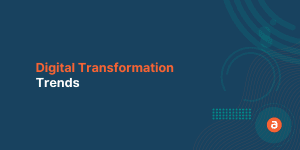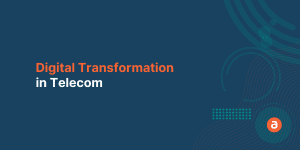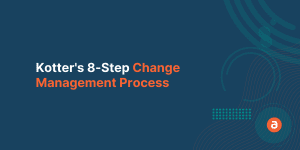The process of hiring new employees doesn’t stop when you find the right people. There is a lot more involved in the new employee onboarding process to ensure that the people you hire will fit in well with your brand, message, workplace culture, and meet the requirements of the position.
New employee onboarding is essential for making employees more productive and increasing employee retention.
Onboarding helps employees become engaged on their first day. When employees are happy and well adjusted in their jobs, they are more likely to stay with their employer. Companies with engaging new hire programs retain 91%* of their first-year workers.
In this guide, we’ll cover the basics of new employee onboarding, including:
- What is onboarding for new employees
- How to onboard a new employee
- Why you need onboarding and orientation
- How to create a new employee onboarding program
- 7 best practices for new employee onboarding
What is Onboarding for New Employees?
New employee onboarding is a process of training, equipping, and acclimating to their new job and company.
Onboarding is social, cultural, technical, and procedural. The goals of a successful new employee onboarding process are:
- Familiarize new hires with company culture and brand
- Introduce employees to their peers and supervisors
- Set expectations for performance and
- Ensure compliance with company processes
How to Onboard a New Employee
“What is your approach to onboarding?” Is a commonly asked question. The answer is that onboarding a new employee is not the same for everyone and depends on the role of the new hire and the organization.
However, there are some standard steps that must be followed. Here’s a quick rundown of the steps to onboard a new employee:
- Create an employee onboarding checklist
- Define attainable goals.
- Introduce them to the team
- Routinely gather feedback
- Provide ongoing support
Relevant Read: Employee Onboarding Questions that Apty helps you Answer
Why You Need Onboarding and Orientation
When you hire new employees, you will want to provide both onboarding and orientation. The two are not interchangeable, and each has essential benefits that will ensure the success of employees.
Orientation is an introduction to the company that gives employees an immediate understanding of who they work for, what the company stands for, and the overall mission. The orientation allows them to know the basics of the company pretty much right out of the gate.
On the other hand, new employee onboarding process allows employees to dive deep into their department and their specific role. They learn about their position in the company and how to seamlessly integrate into the business.
Using both onboarding and orientation, you can set your employees up for success, build employee buy-in and retention, and create a happy and successful team.
How To Create a New Employee Onboarding Program
Most HR managers know it’s one thing to recruit and hire the best talent. It’s an entirely different task to train and retain that talent that you worked so hard to obtain. A company’s continual growth means that there will always be a need for new hire training and development.
With millennials changing jobs faster than generations past, recruitment and retention are more crucial than ever before. Building a comprehensive new employee onboarding program is an investment that should be on your radar.
“Onboarding is not one-size-fits-all. Instead, you must determine what the best fit for your company and its mission is.”
In the meantime, here are four cornerstones to use when building a new employee onboarding program:
A. Be Prepared Ahead Of Time
You may think that the onboarding process begins on a new hire’s first day. In reality, you begin to onboard new hires during recruitment. The entirety of your brand should be considered when you first list an open position.
Include important details like your company culture, brand mission, or any other relevant details that can help prospective employees determine whether they’d be a good fit.
B. Address New Hires’ Urgent First Day Needs
The first day is always nerve-wracking for a new employee. Be sure not to leave a new hire hanging when they begin taking their first steps within your company. It’s important to make new hires feel welcomed, needed, and appreciated.
Work ahead to address common hurdles that pop up during the first few days on the job. Make sure they know where to park, have their ID badge ready, and prepare their computer and workspace.
Allow for open lines of communication to address any questions or concerns that arise. Onboarding software frequently allows for real-time communication, which is a great way for new employees to instantly address any questions that they may have.
C. Personalize The Process
Traditionally, the first days on the job include going over an abundance of HR forms and reviewing company policies. Paperwork is certainly an important part of the new hire process, but it doesn’t help to onboard new employees to their role or company.
A good way to personalize the onboarding process is to ask the new hire for their input on management styles and which one works best. Help them understand their role in the company and how they can make a difference. You want them to feel like they are an asset rather than just a title.
Employers can also implement onboarding software that can be personalized for each employee and their role. Personalized digital onboarding experiences help new hires develop a greater sense of understanding and enable them to take the steps needed for success.
D. Encourage Connection
One of the biggest factors in employee retention is forming connections. Job satisfaction is also highly tied to positive interoffice relationships. Meeting production goals is just as important as establishing an office community built on trust and teamwork.

Make sure your new hire program encourages employees to form relationships with their peers and supervisors. Introduce new employees, include them in meetings, and encourage their input early on.
7 best practices for new employee onboarding
The four points above cover the basics of what your employee onboarding program needs. Additionally, you can consider adopting some of these seven best practices for new hire onboarding.
1. Follow a New Employee Onboarding Checklist for a New Hire’s First Day
Things will go more smoothly for your new hire if you make an effort to prepare the essentials before their first day of work. That includes preparing their workstation as well as their new coworkers for their arrival.
Some things you should generally have ready include:
- Desk and workstation
- Computer and all the necessary accessories
- Any telephones or mobile devices they may have to use
- IDs and access cards
- Uniforms and name tags
- Log-ins and passwords that may be required for the job
- Any other tools or equipment they’ll need to carry out their function
To keep your new hire’s first day from being bogged down with paperwork, try to get as much of it completed beforehand as possible. Items that belong on your new hire paperwork checklist include:
- The employment contract
- Agreements to company policies
- Important payroll forms
- VISA and work requirements
- Other security-related paperwork
When it comes to preparing your current employees for the new hire, make sure to meet with them and let them know who to expect. This is especially important if this is your first time coordinating an employee onboarding exercise. With all those areas taken care of, you’ll have more time to engage with your new hire on their first day.
Relevant Read: Creating an Employee Onboarding Checklist
2. Create a Training Schedule
Ideally, training should begin within your new hire’s first week. The first set of training can focus on the employee’s job responsibilities, the chain of command, company policies, and the foundations they need to understand their job and the company’s culture.
Training should not be restricted to those first few weeks, however. Studies show that employees become more productive with continuous training. It’s recommended that you create a schedule that spans up to the 6-month mark and includes training sessions to improve their job knowledge.
“You’ll also want to consider offering continuous learning – especially when it comes to technology. People prefer to learn by doing.”
Using a digital adoption solution to train and onboard new employees to your enterprise applications can help them master your software and processes in less time.
3. Communicate Expectations and Performance Indicators Clearly

As part of the orientation and training sessions, it’s important to ensure your new hire understands what’s expected of them. In some cases, this means going deeper than the job description they would have already seen.
You should take the time to explain the performance indicators your company uses to define a successful employee. This is also a good time to discuss your probation period and any employee assessments or appraisals.

4. Establish a Mentoring Relationship
One of the keys to a successful onboarding program is that your employee shouldn’t feel like they have been left to fend on their own. While they should receive guidance from supervisors or managers, a mentor program can help the new hire establish a relationship with peers.
A mentor/buddy can help the new hire get used to their new job, office, and coworkers. Mentors are a great resource for employees to ask common questions like where to get supplies or who to talk to about an issue.
“One of the most important parts of onboarding is helping new employees fit into their new workplace’s social dynamics.”
Without a buddy, meeting the team can be awkward and cumbersome – especially for shy people. The buddy system removes some of the burdens of trying to meet everyone on a team.
5. Check-in at Regular Intervals
Probation and assessment periods shouldn’t be the only times you interact with your new hire. Set a calendar reminder to check in on them after a month, three months, and six months.
At each of those points, you can gauge how the employee adapts to their environment and clear up any misconceptions they may have. The information they give you can also feed into the training schedule you’d developed.
By doing this, you build a deeper relationship with your employee, and they won’t feel as if they are being ignored.
Related Read: An Essential Guide for HR Managers to onboard employees
6. Build Developmental and Promotional Plans
Another key part of your onboarding process is developing plans for your new hire’s future in the company. Ideally, this should happen at the end of the employee’s first year.
To do this, you’ll need to combine the information you get from your interactions, assessments, and training sessions. The data may show that they need further training or that they may be eligible for a higher position in time.
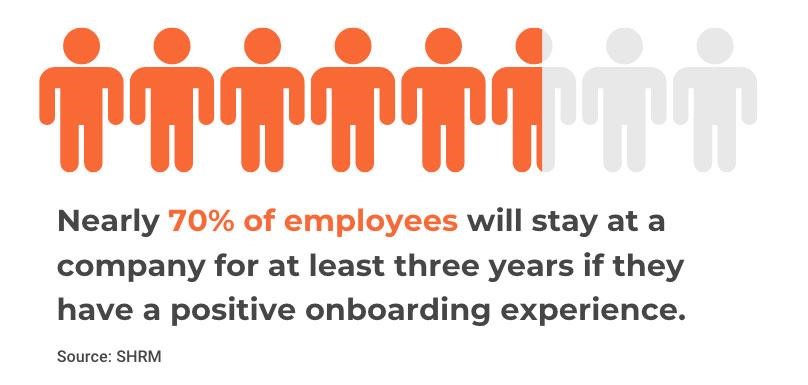
When you pay attention to developing your employee, it makes them feel valued. It also allows them to see their potential future in your company. This is one of the key ways a successful onboarding program can reduce employee turnover.
7. Assess and Improve the Onboarding Process
Much like many processes involving people, there’s always room for improvement. As you’re assessing your new hire, pay attention to any feedback they may have about their new hire experience as well.
It may also help to automate certain aspects of the process, so it doesn’t feel overwhelming for everyone involved.
Make a Good First Impression
“Developing an onboarding process will provide dividends for years to come as your workforce becomes more engaged, loyal, and productive.”
Remember, first impressions are everything. A well-planned onboarding program is the key to long term employee success and satisfaction. Your employees will thank you for taking the time and putting forth the effort to welcome them and give them all of the tools to excel.
*Source: SHRM

